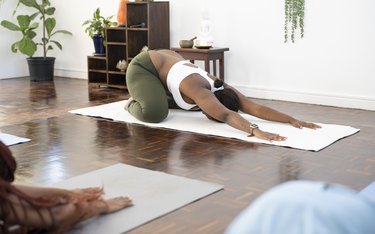
A strong, healthy pelvic floor and kegel exercises go together like peanut butter and jelly, right? Sure. But they're not the only thing you should be doing to support the VIP muscles that support your bladder, bowel and uterus.
While experts agree that kegel exercises can be a key to pelvic health for many people assigned female at birth, performing those little contractions while you're driving or standing in line at the store are just one of a few important practices. (And in fact, it's possible to do kegels too much!)
Video of the Day
Video of the Day
So, what are the others? We chatted with three pelvic floor health experts to find out the other little habits they do day in and day out, and why you should consider following their lead.
1. 'I Do Deep Breathing Regularly'
Ever suddenly notice that you're tensing your shoulders or clenching your jaw because you're stressed or anxious? There's a good chance your pelvic floor muscles are tensed too, which can have consequences for your pelvic health.
"Not being able to relax your pelvic floor muscles keeps them from functioning optimally and can manifest in painful sex, constipation, increased urinary frequency, urinary urgency or urinary incontinence," explains Atlanta-based pelvic physical therapist Amanda Shipley, PT, DPT.
To combat this, Shipley recommends checking in with your body at points throughout the day to consciously relax your pelvic floor muscles by breathing deeply. (She does it hourly!)
Here's how to do it: Sitting still, inhale deeply for four counts while feeling your abdomen expand and relax outwards. "Similarly, you can feel your pelvic floor expand and relax downwards towards your feet, but there shouldn't be any pushing," she says. Exhale slowly for another four counts, repeating the practice once or twice more.
Related Reading
2. 'I Practice Bladder Training'
Bladder training is expert-speak for changing your bathroom habits so you're not running to pee ASAP whenever the urge strikes. Though holding it in might seem harmful or risky, "it's actually not bad for you to postpone urination," explains Beverly Hills-based female pelvic medicine and reconstructive surgeon Karyn Eilber, MD.
In fact, waiting a little bit conditions your bladder to learn to hold more urine (so you don't feel like you have to go all the time). "It also strengthens your pelvic floor because the muscles tighten while you hold it," Dr. Eilber says.
The goal isn't to avoid peeing all day. Instead, when you feel the urge to urinate, hold off for just five minutes before going to the bathroom. After a few days, try to up your wait time to 10 minutes, and gradually make your way up to 20, per the National Center for Biotechnology Information (NCBI).
While you're practicing this, make it a point to avoid going to the bathroom preemptively or "just in case." Doing so can actually train your bladder to need to be emptied even more often, the NCBI notes.
3. 'I Sit When Using the Bathroom, Never Hover'
Hovering over a public toilet seat might seem like a good idea from a germ perspective. But simply sitting is better for your pelvic health.
"Over time, routinely hovering can really mess up your ability to control and coordinate your pelvic floor muscles," Shipley explains. "Hovering sends conflicting messages to the brain because the pelvic floor muscles engage and work to hold your body up over the toilet, but they need to relax in order for the pee to come out."
If you're in a rare situation where you feel like you have to hover, fine. But try to avoid it as much as possible, and definitely don't make it a habit, even if direct contact with the seat skeeves you out. You're better off sitting and using a toilet seat cover (or in a pinch, draping the seat with toilet paper).
4. 'I Have Regular Orgasms'
Climaxing doesn't just feel good — it does your pelvic floor good, too.
"Orgasm encourages blood flow to the area, which helps condition and hydrate the deep connective tissues [to keep them strong]," explains Julie Blamphin, a certified pelvic floor yoga instructor based in Annapolis, Maryland.
While "regular" doesn't necessarily mean the same thing for everyone, from a pelvic floor health perspective, Blamphin recommends trying to reach the big O via sex or solo play a few times per week as long as it doesn't trigger pain. (And if it does, talk with your gynecologist to determine if you should see a pelvic floor therapist.)
5. 'I Don't Hold It In When I Need to Poop'
"If you habitually hold it in and don't let yourself poop when your body tells you it has to go, then your bowels will stop giving you the signal to use the bathroom," Shipley says. This can make stool harder to pass, forcing you to push harder.
Over time, frequent straining can increase the risk for hemorrhoids as well as uterine prolapse (not to mention other problems), Shipley warns. So try not to wait when the urge strikes. When you have to go, don't say no!
Was this article helpful?
150 Characters Max
0/150
Thank you for sharing!
Thank you for your feedback!
Is this an emergency? If you are experiencing serious medical symptoms, please see the National Library of Medicine’s list of signs you need emergency medical attention or call 911.



